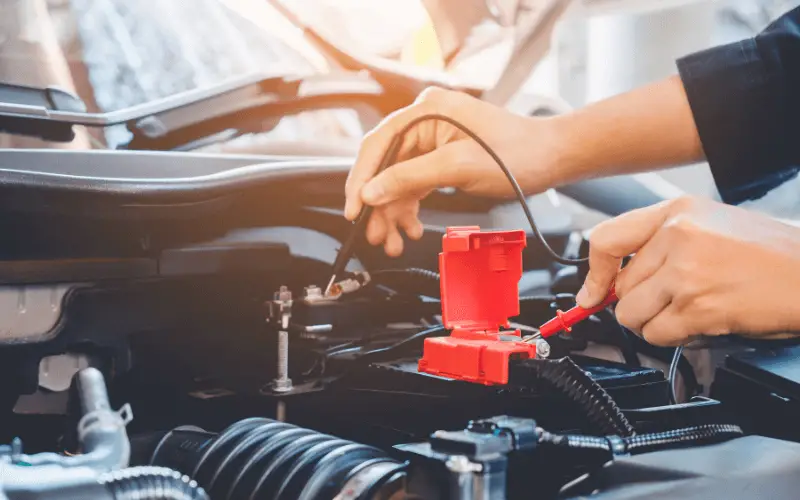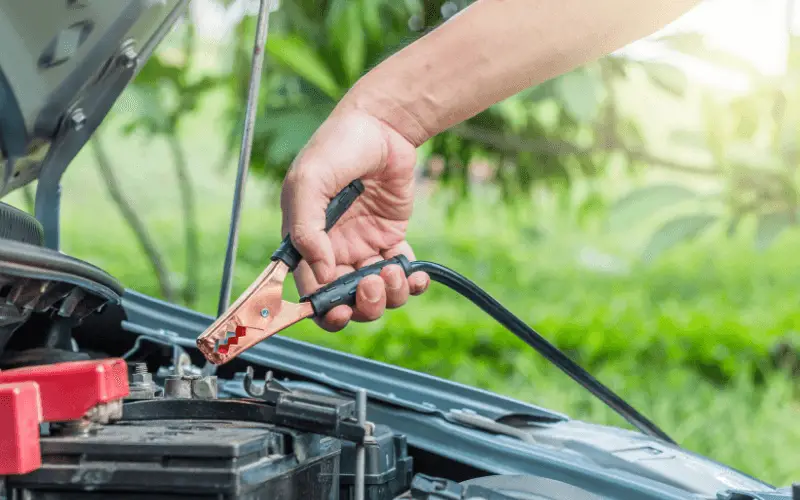Published Date: December 30, 2020
Last Updated on June 22, 2023 by Camper Front
An RV usually has an in-built generator called an alternator. When The engine is in use and spins, the alternator begins to charge your starting battery which then powers all of the electrical devices that your vehicle requires on a day to day basis. In other words, the alternator works to keep the battery full.
If you have house batteries installed in your RV, you can power it off of solar, which is great! But when the weather gets cloudy and this isn’t possible, you would have to get another source of charge for your battery.
In this post, we will be looking at how to charge RV battery with alternator, even if you’ve never done it before.
Table of Contents
How To Charge RV Battery With Alternator
You should note that an alternator is a mechanical device that has lots of moving parts and with constant use, these parts will begin to wear out.
So The harder you work your alternator, the sooner it will begin to fail and If your alternator stops working; your engine will follow suit which means it has to be replaced as soon as possible.
That is why it is recommended to opt for slower alternator charging and a way to turn off alternator charging so that the solar panels can power the equipment, even while driving.
>>> Read Also: Fastest Ways To Charge Your Batteries
How To Charge a DIY Camper House Batteries With An Isolator

An isolator is what connects your house battery bank to your starting battery. So When your engine is turned off, the isolator, “isolates” the two battery banks so that when you make use of the lights, fans, refrigerator, and other devices, your starting battery isn’t drained as this can leave you stranded.
The isolator is simply a pass-through of power which is largely unregulated for the most part in terms of the voltage and amperage that gets sent to the house batteries.
The voltage and amperage that the house batteries receive are dependent on the voltage regulator and amperage output of your alternator.
Charging Rate Of A House Battery Bank From The Alternator
To know the charging rate of house batteries from the Alternator, you need to know the size of the alternator. This enables you to correctly estimate the charging rate. On average, you will receive a charging amperage of 70% of the nominal alternator output.
That means that if you have a 220-amp alternator the most amps that the house battery bank receives is 154 amps. But the actual charging rate of a 220-amp alternator is closer to 100 amps.
So, if you are to charge your house battery at a charging rate of 100amps an hour you would have refilled 100 amp-hours into your house battery bank. This is an estimated figure because when the batteries get closer to full charge it starts to charge slowly.
To estimate the charging rate of your house battery from an alternator, simply calculate 50% of your alternator size in amps times the number of hours you are driving, and this will give you a rough estimate of how many amp-hours will be pushed back into your battery bank.
Advantages Of Charging A Camper House Batteries With An Isolator
- It charges your battery at a rapid rate, over 100 amps in most cases.
- Isolators are less expensive compared to battery chargers
- Isolators have the ability to jump-start a weak starting battery in event of an emergency.
Disadvantages Of Charging A Camper House Batteries With An Isolator
Higher charging rates will cause your alternator to wear out early and also cause overheating in the alternator.
If you have a lithium battery, your alternator may not have enough voltage to charge it to 100% because Lithium Batteries need to be charged at 14.4-14.6 volts once they get near 100% and Vehicle Alternators only put out 13.5V to 14.5V depending on their quality, design, and age.
You will need to make use of large wire sizes, potentially up to 2/0 wire, to minimize voltage drop (Less than 3%) while still accommodating high charging rates.
There are different sizes of alternators and vehicle setups that make predicting charging rates with accuracy quite difficult.
If your Isolator wasn’t specifically designed for lithium batteries, it may have connected/disconnect parameters that may be too low to use with lithium batteries and may not properly disconnect the house and start the battery bank when the engine is turned off.
How To Charge a DIY Camper Batteries With An Li-BIM

The Li-BIM (Lithium-Ion Battery Isolation Manager) is a popular type of isolator that is specifically designed to use with lithium batteries.
They have a higher voltage open/close parameter. This enables the isolator to open and close at more appropriate times depending on the current source of charge which could either be the alternator or shore/solar.
The most unique feature of this isolator is that it helps to combat alternator overheating by providing time-based ‘cycling’. So when the engine is running and the isolator allows the house battery bank to charge for 15 minutes.
Before it disconnects the charge for 20 minutes to allow the alternator to cool, before reconnecting again for 15 minutes, and this cycle continues the entire time the engine is running. This prevents the alternator from overworking.
Charging Rate Of Li-BIM
Because Li-Bim utilizes cycle charging which allows charging for 15 minutes before disconnecting it for 20 minutes, this means that the battery charges 42% of the time.
Using the calculation from earlier, If you have a 220 amp alternator that charges your house battery bank at 100 amps; this means that the battery receives 100 amps, 42% of every hour you are on the road. This gives you 42 amps every hour you are driving.
Advantages And Disadvantages Of Charging Camper House Batteries With The Li-BIM Isolator
- It charges your battery at a rapid rate, potentially over 100 amps depending on the vehicle.
- It is an isolator with voltage connection/disconnection set-points that is designed specifically for Lithium Batteries.
- The Li-BIM has the ability to jump-start a weak starting battery in event of an emergency.
- Its cycle charging feature enables the alternator to cool between high-amperage charging rounds.
- It has higher charging rates which can cause premature wear of the alternator.
- your alternator may not put out high enough voltage to charge Lithium batteries to 100% because Lithium Batteries need to be charged at 14.4-14.6 volts once they get near 100% and Vehicle Alternators can only give out 13.5V to 14.5V depending on its quality, design, and age.
- Although the Li-BIM was specifically designed for lithium batteries, they do not boost their voltage in any way.
- You will need to make use of a large wire size, potentially up to 2/0 wire, to minimize the voltage drop which is usually Less than 3% while also accommodating high charging rates.
- The different sizes of alternators and vehicle setups can make it difficult to predict charging rates accurately
How To Charge A DIY Camper Batteries With A B2B (Battery To Battery) Charger
Using A battery to battery charger takes the voltage and amperage that is being produced by the vehicle alternator and regulates the amperage down to an average pre-set level and it also boosts the voltage as needed so that the batteries can fully charge.
This decrease in amperage greatly lowers the work that is placed on the alternator and this gives you a more accurate number to work with this enables you to be able to accurately determine how many amps the charger will operate at.
A boost in the voltage is very important in order to be able to charge higher-voltage lithium batteries from the alternator that may not be able to put out much voltage.
If the power from the alternator is hitting the DC-DC Charger at 13.8V and the batteries need to be charged at 14.6V, the DC-DC Charger will boost the 13.8V it receives from the alternator to the 14.6V that the batteries required.
On DC-DC Chargers, you can also program the voltage so it will work for Lithium, AGM, Carbon Foam, Salt Water, or whatever other types of battery you use it to charge.
>>> Read Also: What Can You Run on a 2000 Watt Generator?
Charging Rate Of A DC-DC Charger
Each DC-DC charger has different charging rates. For example, if you are making use of the Victron Orion 12|12 – 30 it will charge your house battery bank at 30 amps. This means that if you drive for an hour, your battery receives 30 amps per hour.
Advantages And Disadvantages Of Charging Camper House Batteries With A B2B (Battery To Battery Charger.
- It Can regulate amperage which makes system planning easier and also decreases the strain placed on the alternator.
- It Can deliver a specific programmable charging profile to the batteries.
- It can be used to boost sub-optimal voltage to a level required to charge batteries to 100%
- Some models of DC-DC Chargers can be run in parallel, this provides them with more amps if needed.
- It cannot jump-start the engine battery from the house battery bank which might be needed in case of emergencies.
Conclusion
Relying on your solar to charge your battery isn’t the best thing to do when heading out for a trip with your camper.
That is why most people have divulged into other charging options, so if you have been trying to figure out how to charge RV batteries with alternators, hopefully, this article has explicitly explained the process.

